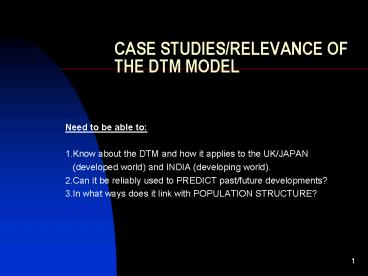CASE STUDIESRELEVANCE OF THE DTM MODEL - PowerPoint PPT Presentation
1 / 17
Title:
CASE STUDIESRELEVANCE OF THE DTM MODEL
Description:
DR falls (National Insurance 1911/TB treatments. via Local Councils 1921/pension schemes)Rapidly ... British colonisation=medicine/health/water/sanitation ... – PowerPoint PPT presentation
Number of Views:24
Avg rating:3.0/5.0
Title: CASE STUDIESRELEVANCE OF THE DTM MODEL
1
CASE STUDIES/RELEVANCE OF THE DTM MODEL
- Need to be able to
- 1.Know about the DTM and how it applies to the
UK/JAPAN - (developed world) and INDIA (developing
world). - 2.Can it be reliably used to PREDICT past/future
developments? - 3.In what ways does it link with POPULATION
STRUCTURE?
2
DTM and the UK
- Stage 1 until 1740 BR 30-40/000
- DR a little lower (cheap GIN
drinking) - Stage 21740-1880 DR falls to 20/000
(food/sanitation/ - water/smallpox 1798/Public
Health Acts 1848/1875 - BR stays high _at_ 30-35/000
- Stage 3 1880-1920 BR falls to 15/000
(birth control - information 1876,1914/1918
WW1) - DR falls (National Insurance
1911/TB treatments - via Local Councils
1921/pension schemes)Rapidly - urbanised rather than rural
society-ease of medical - treatments/hospitals/politic
al-Suffragettes 1897. - Stage 4 Low BR/DR_at_ 15-20/000.
- Some baby booms-post WW2 in
1946. - Contraceptive Pill in 1963
3
Does the DTM workin the UK ?
- NOTECompare your DTM in the UK graph
- with the DTM expected graph on p151.
- OVERALL TREND?GIVE EXAMPLES..QUOTE DATA
- EXCEPTIONS TO THE RULE?.WHEN?QUOTE DATAWHY?
- CONCLUSION?
- Help? For exceptions look _at_ 17201780.1820/60.19
46Stage 5?
4
DTM IN MEDCS
- Rate/000
- B R
- D R
-
-
Time
5
DTM IN LEDCS
- Rate per 000
- B R
- D R
-
Time
6
DTM IN INDIA
- POPULATION GROWTH (mil)
CHANGES IN BR
AND DR - 1000
BR - 500
DR - 1901
2000
1901
2000
7
DTM IN INDIA
- Stage 1pre-1920BR _at_ 50/000 DR _at_ 40/000
- rural life/highly prized male
children - Stage 21920-1985DR reduces _at_ 30/000 by 1942
- BR remains high-massive natural
increase - British colonisationmedicine/health
/water/sanitation/ - industrialisation/quality of
food/technology/oppression/ - independence in 1948.Over 50 pop
below 15. - Stage 3Post-1985DR levelling off,BR high but
starting to decline - so family size falling.987 millions
population.N I _at_ 1.9 - CBR28/000 CDR 9/000 (low compared
to some European) - Still largely agricultural but
increasing industrialisation - GNP 370 (in UK20,870)
- Strong social/religious
customswill BR fall further,quickly?
8
Does the DTM workin INDIA?
- NoteCompare your DTM graph of India with
- the expected DTM graph on p 151.
- OVERALL TREND?..QUOTE EGS.DATA
- EXCEPTIONS TO THE RULE?..QUOTE
EGS.DATAWHEN?.WHY? - CONCLUSIONS?
- Note1901 BR/DR,1921-1981 constant fall of BR.no
sign DR levelling
9
Does the DTM work .in JAPAN?
- Rate per 000
- 40
-
BR - 30
-
DR - 20
- 1900
1939
2000
10
DTM IN JAPAN
- STAGE 1pre-industrial society up until
1870.Subsistence - economy.BR/DR _at_ 20/000 NI _at_
1-1.6 - STAGE 2urbanisation as Industrial Revolution hit
Japan. - improvements in food
suply/living conditions/ - access to medical facilities led
to increase in - BR to 35/000 in
1920.Industrialisation/reduction in DR. - STAGE 3 1945-1979- boom post WW2/Eugenic
Protection Laws in - 1960s/BR therefore drops
dramatically/1966 is - year of Fire and
Horse-unlucky-fewer still babies/ - rapid post-war
industrialisation/improving Q of L. - STAGE 41979 onwards BR/DR low-advanced
Technological lifestyles.
11
Does the DTM work in JAPAN?
- NoteCompare the DTM graph of Japan
- with the expected DTM graph p 151.
- OVERALL TREND.. QUOTE EGS..DATA
- EXCEPTIONS TO THE RULE?QUOTE EGS.DATA..WHAT..
WHY - CONCLUSIONS?
- Note1850 limited fluctuation BR/DR,1870 BR
rise,fluctuating BR decline, - DR continuing to decline 2000,timescale
of overall change?
12
DTM and POPULATIONSTRUCTURE
- POPULATION STRUCTURENORMALLY REFERS TO THE
-
AGE/SEX PROFILE OF A -
COUNTRY.CAN ALSO INCLUDE -
RACE,LANGUAGE,RELIGION, -
FAMILY SIZE. - AGE/SEX RATIOS normally shown via a POPULATION
PYRAMID
13
Population Pyramid
- AGE OF GROUPS
- 15-29
- 0- 14
14
The DTM and PopulationPyramids
- 1.Predict the changes that should happen
- to a countries Population Pyramid,as
- it progresses through the expected
- Demographic Transition Model.
- 2.Draw your predicted changes to the Population
- Pyramids of India,UK,Japan,for 2025 and 2050.
- Are they correct? Compare with UN predictions
- given out to you?
15
HOW RELIABLE THENIS THE DTM?
- ESSAY
- By reference to examples that you have studied at
different scales of development,critically
appraise the Demographic Transition Model.(25)
16
ESSAY TIPS
- 1.Introduction. Refer to DTM.What it is,how it is
supposed to be helpful to prediction
NI/population structure change in a country/when
developed/stages/dates/etc - 2.Refer to egs from MEDC.Stage by stage
comparison of - each countries progress.Is there comparison
with DTM/in - what way/is there disagreement/in what way?Why?
Use FACTS - 3.Do the same for LEDC.
- 4.Does it tend to work better for MEDC or LEDC?
Use FACTS - 5.Overall conclusion?Why? Any better models? Any
use for - predicting future trends?
- http//www.uwmc.uwc.edu/geography/Demotrans/demtra
n.htm - http//www.geocities.com/geogsoc2000/DTM.html
- Or write in Demographic Transition Model into
Google search engine,and start your own search.
17
REVIEWDEMOGRAPHIC TRANSITION MODEL
- Simplistic model based upon the work of American
Demographer Warren Thompson.(1929) - Not all countries/regions within countries pass
through stages _at_ same - time/rate.
- No account taken of base population size(a small
NI in Chinamassive population growth!) - No account taken of the impact of Migration
- Based largely upon western/consumerist/market
led societies. - No account of external control/investment in a
country (eg,Colonial power) - Heavily reliant upon economic factors,eg,GNP,to
cause stage by stage changes - Under emphasis of culltural/political/social
factors in stage by stage changes - Fairly accurate overall indicator of NI
change.Therefore highly regarded model































